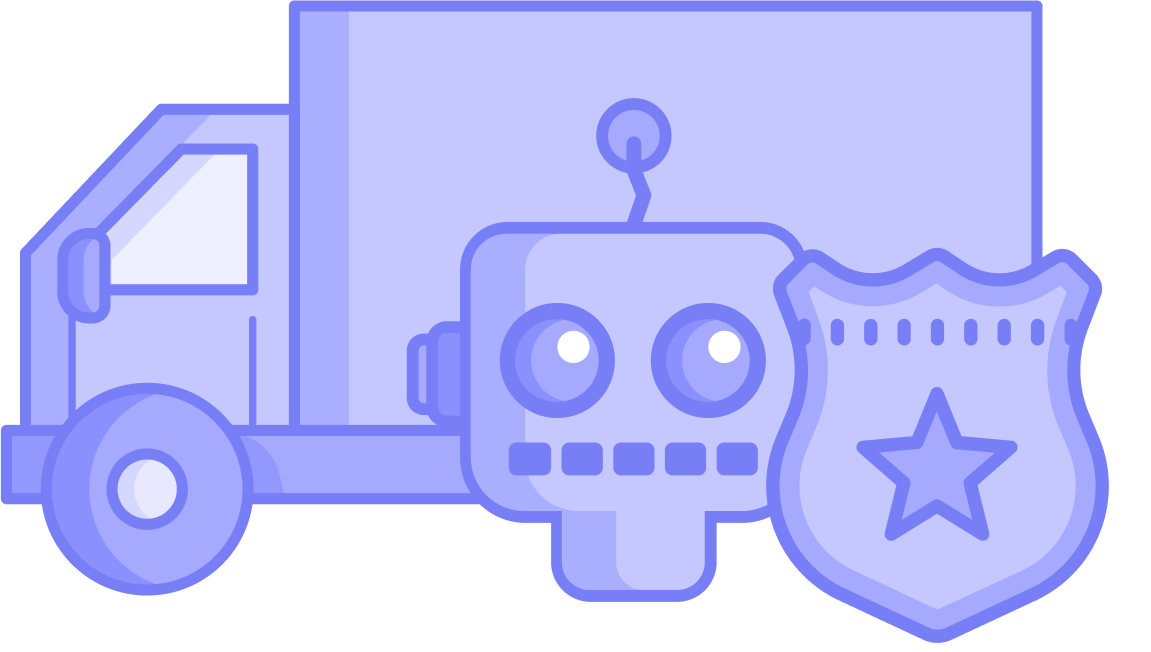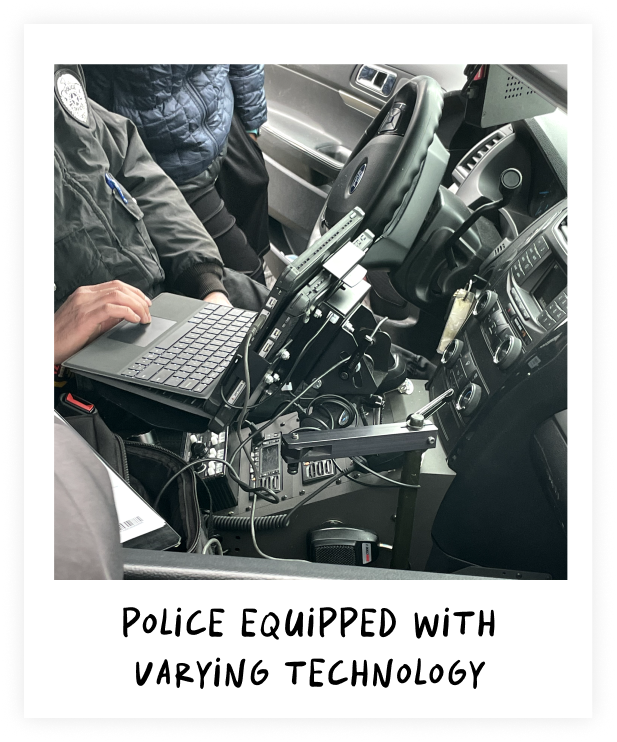
The question that Torc tasked us to answer is: How might police interact with driverless trucks?
As such, our problem space lies at the intersection of three different domains: law enforcement, the trucking industry, and autonomous technology. Each of these domains is highly complex and variable, consisting of many moving parts.
From interviewing key stakeholders to directly observing police-truck interactions, we conducted research from multiple angles and surfaced some important insights. Continue reading to learn more!
The lack of standardization in the technology infrastructure for law enforcement and trucks, combined with highly variable environmental constraints, eliminates the ability to assume any consistency across different interaction contexts.

Different police officers and truck drivers are equipped with varying devices and levels of training or experience.

The technology from car to car depends on how cheap the police department is and what they want to spend money on...

— Police Officer

Even though police officers are issued devices by their department, they often leverage their personal devices for the sake of convenience.

The department issued tablets... [but] I take pictures on my phone, just because it's easier...

— Police Officer

The more experience police officers have with inspecting trucks, the more they rely on indicators such as vehicle size, reputation, and safety rating to make systematic decisions about which trucks to inspect.

The larger and heavier a vehicle is, the more damage it might generate if involved in a road accident. Police are often more attentive to these high-risk vehicles.

Those eighteen-wheelers can cause a lot of damage if they topple on the highway...

— Police Officer

Our company has a pretty good reputation... but that’s not the case for companies that often hire unskilled, unexperienced drivers...

— Truck Driver

Some truck companies have a poor track record of violations and unlawful drivers, so police might be more likely to inspect them.

If the goal is to limit the number of spontaneous inspections that police perform with a truck, it is important to establish a good track record or reputation as soon as possible.

Proactively inviting police to perform an inspection and getting an up-to-date decal + good safety rating on record may deter police from performing further inspections.
The more experience police officers have with inspecting trucks, the more they rely on indicators such as vehicle size, reputation, and safety rating to make systematic decisions about which trucks to inspect.

The larger and heavier a vehicle is, the more damage it might generate if involved in a road accident. Police are often more attentive to these high-risk vehicles.

Those eighteen-wheelers can cause a lot of damage if they topple on the highway...

— Police Officer

Our company has a pretty good reputation... but that’s not the case for companies that often hire unskilled, unexperienced drivers...

— Truck Driver

Some truck companies have a poor track record of violations and unlawful drivers, so police might be more likely to inspect them.

If the goal is to limit the number of spontaneous inspections that police perform with a truck, it is important to establish a good track record or reputation as soon as possible.

Proactively inviting police to perform an inspection and getting an up-to-date decal + good safety rating on record may deter police from performing further inspections.
Although there is a standard checklist of what to do during inspections, a police officer's approach is non-linear, contextual, and dependent on specific instructions from the their specific department/state and the truck manufacturer.

A police officer's physical position and location vary a lot as they move around to inspect different parts of the vehicle.

Every officer has their own style of doing inspections, some do clockwise, some counter-clockwise...

— Police Officer

Inspections can be fun when the weather is nice, but the melting ice was dripping all over me when I was under the truck today...

— Police Officer

Different contextual circumstances, such as bad weather conditions, can affect how an inspection is performed.

The interaction medium through which the inspector communicates with the truck should be accessible regardless of the inspector's location (e.g., around, inside, and underneath the truck)

Knowing how different circumstances may influence an inspection, adapting to specific contexts could better facilitate the interaction between the police and truck.
Police officers currently rely on verbal and gestural language to communicate with truck drivers. They worry that, when interacting with driverless trucks, their experience will no longer be relevant and communication might not be as fluid or effective.

Police officers usually shout out instructions from different locations around the truck so that drivers know what to operate from the cabin.

Drivers work with us during inspection... We shout and they execute, so without them, it will be a lot of work on us... I like these technology advancements but I hope I’m retired by the time they become a reality...

— Police Officer

Drivers can see which way I'm pointing from the rearview mirror...

— Police Officer

Police officers often gesticulate with their hands to specify instructions. This is very helpful for drivers who don’t speak English fluently.

Given that police officers have a habit of using verbal and non-verbal language during inspections with drivers, capturing multiple modalities of input would be necessary to more accurately and fully understand the user's intention.

Police officers believe that removing human drivers from the picture might interfere with rather than help with their goals. Interactions with driverless vehicles would likely require new training, create new uncertainties, and undermine the wealth of experience they've gained thus far.
The lack of standardization in the police and trucks' technology infrastructure, combined with highly variable environmental constraints, eliminates the ability to assume any consistency across different interaction contexts.

Different police officers and truck drivers are equipped with varying devices and levels of training or experience.

The technology from car to car depends on how cheap the police department is and what they want to spend money on...

— Police Officer

The department issued tablets... [but] I take pictures on my phone, just because it's easier...

— Police Officer

Even though police officers are issued devices by their department, they often leverage their personal devices for the sake of convenience.

The technology that police officers use widely varies, not only because their departments issue different equipment, but also because police sometimes use personally owned devices in a professional capacity.

A number of external factors such as network bandwidth, device battery, or unintended audiences may exist in the environment, thus limiting or complicating the police officers' ability to leverage the technology at hand.
The question that Torc tasked us to answer is: How might police interact with driverless trucks?
As such, our problem space lies at the intersection of three different domains: law enforcement, the trucking industry, and autonomous technology. Each of these domains is highly complex and variable, consisting of many moving parts.
From interviewing key stakeholders to directly observing police-truck interactions, we conducted research from multiple angles and surfaced some important insights. Continue reading to learn more!

The technology that police officers use widely varies, not only because their departments issue different equipment, but also because police sometimes use personally owned devices in a professional capacity.

A number of external factors such as network bandwidth, device battery, or unintended audiences may exist in the environment, thus limiting or complicating the police officers' ability to leverage the technology at hand.
The lack of standardization in the technology infrastructure for law enforcement and trucks, combined with highly variable environmental constraints, eliminates the ability to assume any consistency across different interaction contexts.

Different police officers and truck drivers are equipped with varying devices and levels of training or experience.

The technology from car to car depends on how cheap the police department is and what they want to spend money on...

— Police Officer

The department issued tablets... [but] I take pictures on my phone, just because it's easier...

— Police Officer

Even though police officers are issued devices by their department, they often leverage their personal devices for the sake of convenience.

The technology that police officers use widely varies, not only because their departments issue different equipment, but also because police sometimes use personally owned devices in a professional capacity.

A number of external factors such as network bandwidth, device battery, or unintended audiences may exist in the environment, thus limiting or complicating the police officers' ability to leverage the technology at hand.